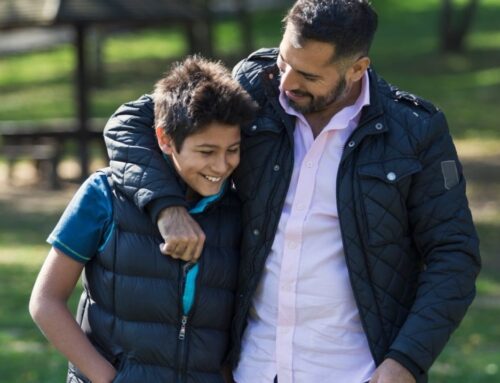In Traditional (or Dominant-Non-Dominant) Relationships
One member of the pair is dominant and makes the ultimate decisions for both partners. One may be dominant in all aspects of life or may take over dominance in certain aspects of life. In the Traditional style the emotional connection and opportunities for intimacy building vary for each couple because the degree of closeness and sharing is dependent on the desires and expectations of the person who is more dominant.
Many Traditional couples report satisfying relationships, and some point out that it results in successfully circumventing potential power struggles and conflicts. Some even feel it is a God-given preference. The Traditional style can spell out roles and tasks very clearly when there are young children to raise or when one person has the main bread-winning function and is on a career path that requires intense involvement.
You might know a couple like Al and Sharon, who exemplify the Traditional relationship style. Sometimes such couples are comfortable in their ways, or one isn’t ready or willing to change. Such was the case with Al. At the time when Sharon got him to participate in a complimentary exploratory coaching session, he did not understand the need for change. He professed perfect willingness for Sharon to find ways to “make herself happy.” Sometimes this happens in couples. Then it’s in the hands of the mate who wishes change to find ways to grow independently while staying connected and not destabilizing the relationship they value in other ways.
Sharon and Al
Here’s a bit about Sharon and Al’s story, which is left unresolved because they did not pursue further coaching together. While this couple may appear quite extreme in their dominant-non-dominant roles, I offer it here so you can listen for any snippets of the Traditional Style in your relationship.
Al is a high-level vice president at a Midwestern manufacturing company. It’s a position he’s grown into since beginning at the company shortly out of college. With a degree in engineering, he comes from a family culture of 1950s-style family values. He and Sharon are in their early thirties, with three children under the age of nine. Sharon is a stay-at-home mom and a standby-your-man kind of woman. She never questions Al’s work choices, including their frequent job-related moves around a 7 state region. She and the kids have had a hard time making long-term friendships. She hopes they stay in their current town until the kids have grown, but that decision will be left to Al.
Sharon is proud to be at Al’s side at church, and at community and social events. They are both pleased with her role as Al’s wife, and with her skills as a homemaker. She enjoys having dinner on the table at seven, shortly after Al arrives home from the office. If they have plans to go out for the evening, Sharon will have made arrangements for the sitter. Al spends time with the children after dinner until Sharon takes over and gets them ready for bed.
Sharon and Al came to see me because their relationship was feeling routine and Sharon didn’t know why she was dissatisfied. I became concerned that their relationship did not make room for individual growth. I wondered if they could accommodate the conversations, openness to hearing one another’s dissatisfaction, and change that are hallmarks of true intimacy. Al seemed content with the way things were going and I wasn’t sure he was concerned about Sharon’s growing dissatisfaction.
The opportunity for connection and intimacy building in the Traditional style is dependent upon the choices, needs, and desires of the person with the most power. When that person, feels that time with his partner is important and valuable, then talking, affection, and sex may occur on a regular and mutually fulfilling basis. If, however, the dominant person is out of touch with the other person’s needs, or simply doesn’t think those needs are important, then connection and intimacy is missing.
ADDITIONAL GREAT READS FOR YOU
- In contrast, check out the story of Irina and Milo whose relationship “appears” Traditional in their surface roles, however they relate in a true Big Picture Partnering way. This impacts all aspects of their connection—communication, decision-making and intimacy.
- Or – read about Harvey and Lenore who partnered creatively together and made dramatic lifestyle and work changes.
- Then Marybeth and Ron are an example of facing tough differences in what they wanted, but exploring it by partnering together came to a happy solution.
Reflect on your own relationship.
- What aspects feel ‘merged’ to you? Consider if this is due to choice, possibly not claiming or communicating your own needs, or an unconsciousness on both your parts—possibly acting out role models in your families.
- Then, in case you missed it, return to the article Keys to Confidence, Security and Emotional Connection for Couplesto continue learning about all 4 relationship styles.
- And if you haven’t already, download your relationship style assessment here
- Learn more about our unique approach to Couples Coaching now.
- Or check out all of our online coaching programs and events by visiting drjanhoistadpartners.com/online-courses-events/
MORE RESOURCES
- Chet and Sue were first introduced in the book Book Picture Partnering: 16 Weeks to a Rock Solid Relationship, learn more here.
- Learn more about the Big Picture Partnering Coaching approach.
- Contact Dr. Jan for a Complimentary call to discuss your needs here.
- Three Ways to Advance Your Career - October 7, 2024
- How to Take Your Business to the Next Level - October 3, 2024
- Coaching for Business Partners: 4 Times to Work with a Skilled Business Relationships Coach - September 12, 2024






